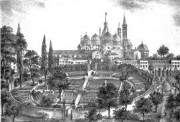 Monday october 14th, 2013 the Botanical Garden of Padua, has been inaugurated; restored and enlarged.
Monday october 14th, 2013 the Botanical Garden of Padua, has been inaugurated; restored and enlarged.
The Botanical Garden of Padua or ” garden of the simple ones ” ( the “simple ones” was the denomination of the medicines directly derived from Nature ), founded in 1545 AD, is the oldest University Botanical Garden presently existing in the World, its creators introduced there about 1800 medicinal plants both for therapeutic purposes and for studying and since then the number of plants present has increased from year to year. The Garden increased the already strong reputation in the study of plants of the ancient University of Padua, and a circular wall was built all around it in 1552 AD to protect the precious hosted plants against continuous theft. In 1835 A.D. a library ( books, herbals dry, paintings, photographs, antiquities and historical evidences ) and a herbarium then become a great collection of dried plants (fruits, algae, lichens, fungi, etc …) coming from the Americas, Asia , Europe and Asia were built
In 1997 A.D. the Garden was listed as a World Heritage Site by UNESCO, for this quoted reason:
“The Botanical Garden of Padua is the original of all botanical gardens in the world and is the cradle of science, of scientific exchanges, and understanding of the relationship between nature and culture. Has largely contributed to the advancement of many modern scientific disciplines , particularly botany, medicine, chemistry, ecology, and pharmacy. “
.
In 2008 AD the extension work of the Garden have started,adding up to the 7000 square meters of the historical part another 15000 technological square meters. The vegetable species hosted in the Garden exceed now 6,000 different units. Were built five new, large greenhouses and three main routes were prepared:
1. The plant and the environment ( with over 1300 new species housed in areas that reproduce the various terrestrial ecosystems: from the tropical to the sub-arctic ) leads visitors through the tropical rainforest, the subhumid tropical forest, the savannah, the temperate mediterranean area, the desert with an arid climate, the Arctic tundra, the alpine tundra and finally Antarctica.
2. The plant and the man (the evolution of human intelligence togheter with that of the plant ) with movies, interactive panels and greenhouses that tell the Planet from the point of view of the vegetable life forms, which are able to interact with the environment in twenty ways different.
3. The plant in the outer space, with forecasts and projections about the potential, extra-terrestrial life and the effects produced by human pollution over vegetable species.
Visit the official site of the Botanical Garden of Padua






Leave a Reply